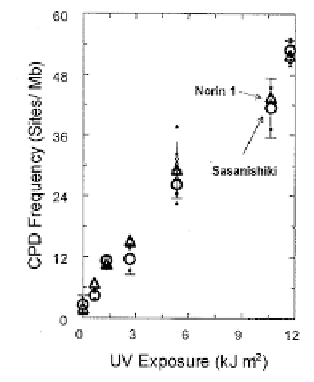Environmental Engineering Reference
In-Depth Information
Investigators determining the effects of UVB supplementation on various rice strains
found that Norin 1 was exquisitely sensitive to added UVB, compared with closely
related strains.
Further, the effect of supplemental UVB on other close relatives, e.g.,
Sasanishiki, could be ameliorated by the addition of additional white light. However, the
detrimental effect of UVB could not be effectively prevented by white light
supplementation. These data suggested that Norin 1 might be UV sensitive due to some
deficiency in protection against UV, perhaps due to increased DNA damage or
decreased DNA repair. The lack of improved UV-resistance under conditions of
increased white light further suggested that Norin 1 might be deficient in light-mediated
DNA repair or photorepair, the principal repair path of UV-induced DNA damage in
most plants. [Background studies had already shown that Norin 1 did not differ
significantly in non-repair physiological responses from its relatives.]
The first possibility was that Norin 1 was deficient in UV-protecting pigments
or other cellular components, so that more damage would be formed per unit UV
exposure than in its UV resistant relatives. The level of CPD per unit dose was thus
determined in Norin 1 and Sasanishiki; the data clearly indicate that similar levels of
CPD are formed in seedlings of both strains. Thus, equal exposures of UVB to these
Figure 7. Equal pyrimidine dimer formation in Norin 1 and Sasanishiki rice seedlings.
strains induce equal frequencies of DNA damage [3]. This shows that the UV sensitivity
of Norin 1 did not stem from induction of more damage than in the UV resistant
Sasanishiki.
Although these data suggested that Norin 1 might be defective in some repair
path of UV damage, it did not indicate which repair path was affected. Hidema et al.
evaluated nucleotide excision repair and photorepair in seedlings of Norin 1 and of
Sasanishiki [3]. They found that UVB-irradiated seedlings of Norin 1 carried out
photorepair much more slowly than Sasanishiki, whereas (within the time examined) the
excision properties were similar.

Search WWH ::

Custom Search